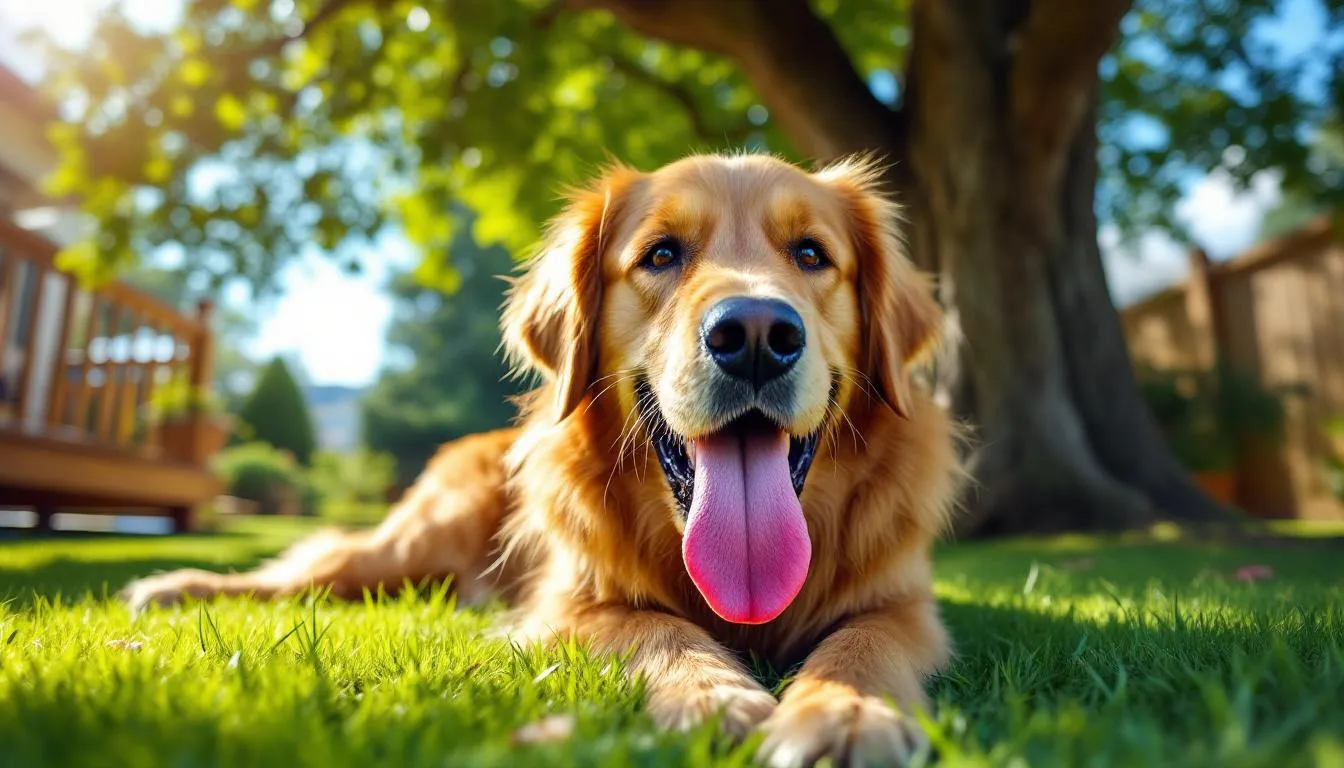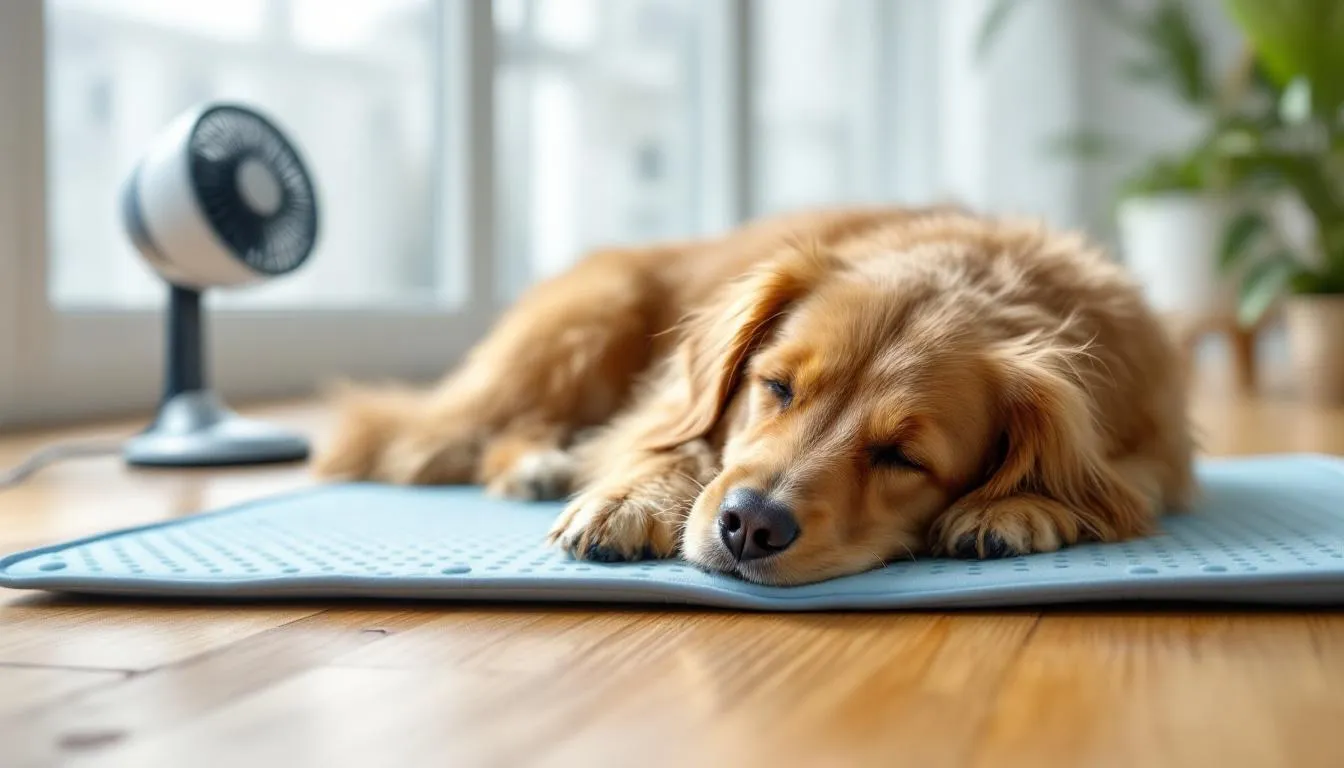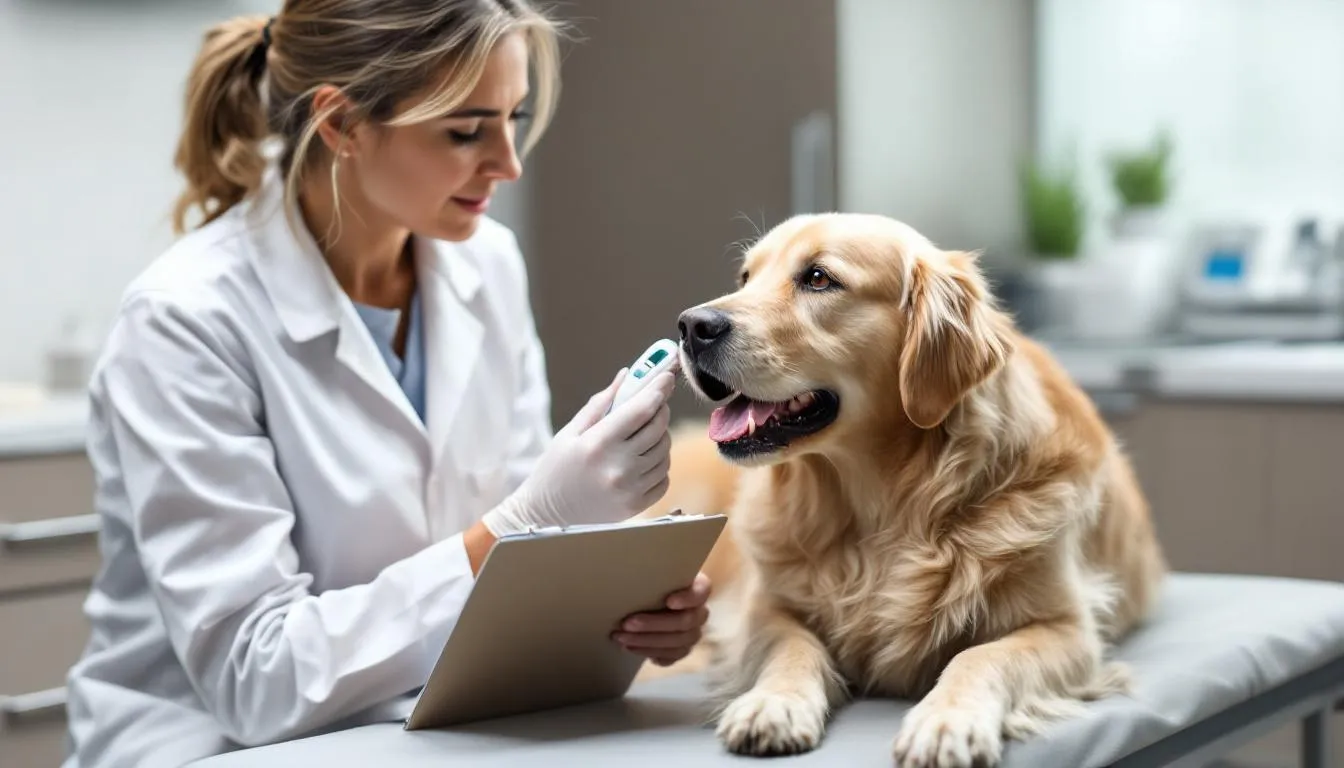

Key Takeaways
Move your overheated dog to a cool, shaded area immediately and offer fresh water
- Move your overheated dog to a cool, shaded area immediately and offer fresh water
- Apply cool (not cold) water to your dog’s belly, paw pads, and armpits for effective cooling
- Use fans and cooling mats to help lower your dog’s body temperature safely
- Watch for heatstroke signs like excessive panting, drooling, weakness, and collapse
- Contact your veterinarian immediately if symptoms persist or worsen after cooling attempts
Apply cool (not cold) water to your dog’s belly, paw pads, and armpits for effective cooling
Use fans and cooling mats to help lower your dog’s body temperature safely
Watch for heatstroke signs like excessive panting, drooling, weakness, and collapse
Contact your veterinarian immediately if symptoms persist or worsen after cooling attempts
When summer heat strikes and your dog starts panting heavily, every minute counts. Unlike humans who can sweat to regulate body temperature, dogs rely primarily on panting and limited sweating through their paw pads to stay cool. This makes them particularly vulnerable to heat related illnesses, especially during hot or humid weather conditions.
Knowing how to cool down a dog safely can mean the difference between a minor heat exhaustion episode and a life-threatening emergency. Whether you’re dealing with an overheated dog after a walk or preparing for the hottest parts of summer, this guide provides essential cooling methods that every dog owner should know.
Understanding Why Dogs Overheat
Dogs face unique challenges when it comes to temperature regulation that make them more susceptible to overheating than their human companions. Most dogs primarily cool themselves through panting, which involves rapid breathing that allows moisture to evaporate from their tongues and respiratory tract. This cooling process becomes far less efficient when air temperatures rise or humidity increases. It is important to monitor your dog's temperature during hot weather, as a rapid increase can signal the onset of overheating or even heatstroke.
Thick coats trap heat close to the dog’s body, creating an insulating layer that works against them in summer heat. While these coats protect from cold weather, they become a liability when trying to dissipate heat effectively. The dog’s body temperature can rise quickly when their natural cooling mechanisms become overwhelmed.
Flat faced dogs, also known as brachycephalic dogs, face particularly high risks during hot weather. Breeds like bulldogs, pugs, and boxers have shortened airways that make panting less efficient. Their restricted breathing passages mean they struggle more to move the air volume needed for effective evaporative cooling.
Your dog's breed affects how they handle heat in other ways too. Dark-coated dogs tend to absorb heat from direct sunlight, while their lighter-colored counterparts may actually have an advantage in reflecting solar radiation. However, dogs with very light or thin coats face increased risk of sunburn, especially on exposed areas like the nose and ear tips.
Senior dogs, puppies, and overweight pets represent higher-risk categories for heat related illness. A senior dog may have compromised heart function or other health issues that affect circulation and temperature regulation. Puppies haven’t fully developed their heat tolerance, while excess weight creates additional internal heat and reduces the dog’s ability to cool effectively.
Understanding a Dog’s Life and Health
Dogs depend on a stable body temperature to stay healthy and active, just like people do. Their normal body temperature ranges from 100°F to 102.5°F (37.8°C to 39.1°C), and even a small increase can put them at risk for heat related illnesses. In hot weather, dogs rely on panting and a small amount of sweating through their paw pads to release excess heat. Unlike humans, who can sweat over most of their bodies, this cooling process is much less efficient for dogs—especially during hot or humid weather.
Certain dogs are more vulnerable to overheating. Flat faced dogs, such as bulldogs and pugs, have a harder time moving air efficiently, making it more difficult for them to cool down. Senior dogs may have health conditions that affect their ability to regulate body temperature, while dogs with thick coats can trap more heat close to their bodies. In humid weather, the air holds more moisture, which makes panting less effective and increases the risk of heat related problems.
Because dogs rely on these limited cooling methods, it’s essential to keep your dog cool and provide plenty of opportunities to rest in shaded or air conditioned areas. Paying close attention to your dog’s comfort and body temperature during hot days helps prevent dangerous heat related illnesses and keeps your dog safe and healthy all summer long.


Immediate Cooling Methods
When you notice signs of an overheated dog, immediate action becomes critical. The goal is to lower your dog’s body temperature gradually and safely, avoiding shock while providing rapid relief. To cool your dog effectively, use safe and proven methods that help reduce their temperature without causing harm. Research shows that proper cooling techniques can prevent progression from heat exhaustion to potentially fatal heat stroke.
Move to Cool Environment
The first step in helping an overheated dog involves removing them from the heat source immediately. Bring your dog inside where air conditioning can provide instant relief from external heat sources. If you don’t have air conditioning, move to the coolest area of your home, typically a basement or the coolest room with tile flooring.
Create distance from direct sunlight and hot surfaces that continue to add heat to your dog’s body. Hot concrete, asphalt, or sand can burn paw pads while simultaneously heating your dog from below. Even when seeking outdoor shade, remember that ambient air temperatures remain high, making indoor cooling far more effective.
Never leave your dog in a hot car, even briefly. Car interiors can reach deadly temperatures within minutes, even with windows cracked. The enclosed space traps heat and creates an oven-like environment that can quickly become fatal.
Water Cooling Techniques
Cool water provides one of the most effective methods for lowering a dog’s temperature, but technique matters significantly. Pour cool water over specific areas where blood vessels lie close to the surface: the belly, paw pads, armpits, and groin areas. These locations allow for maximum heat transfer from your dog’s body to the cooling water.
Use cool not cold water, ideally between 65-70°F. Water temperature that feels comfortable to your hand works well. Ice water can actually be counterproductive by causing blood vessels to constrict, which reduces the body’s ability to dissipate heat effectively and may lead to shock.
If using a garden hose, let the hot water run out first before applying it to your dog. The initial water from hoses sitting in the sun can be scalding hot. Test the water temperature on your own skin before directing it toward your dog.
For drinking water, offer small amounts of fresh water frequently rather than allowing your dog to gulp large quantities. An overheated dog may vomit if they drink too much too quickly, which can lead to dehydration and complicate the cooling process.
Recent studies have shown that voluntary head dunking in tepid water around 70°F provides remarkably fast initial cooling. If your dog is trained to dunk their head voluntarily, this method can reduce temperature within the first 30 seconds and maintain lower temperatures for several minutes.
Cooling Accessories and Tools
Cooling mats designed specifically for pets provide a comfortable surface that helps draw heat away from your dog’s body. These mats use gel technology or phase-change materials that activate when your dog lies down, providing sustained cooling without electricity.
Position fans to increase air circulation around your dog, especially if their fur is damp from cooling efforts. Moving air enhances evaporative cooling by speeding moisture evaporation from the coat and respiratory system. This creates a more effective cooling environment than still air.
Ice packs wrapped in towels can be applied to the neck and armpit areas for 5-minute intervals. Direct ice contact should always be avoided, but these targeted applications help cool major blood vessels. Remove ice packs if your dog begins shivering, which indicates overcooling.
Damp towels placed on the neck and groin can assist cooling, but monitor them carefully. Remove wet towels if they become warm, as they can actually trap heat and work against your cooling efforts. The towels should feel cool to the touch throughout the application.


Prevention Strategies for Hot Weather
Smart prevention strategies keep your dog safe during hot weather and reduce the need for emergency cooling measures. Prevention is key to keeping dogs cool and comfortable when temperatures rise. Planning ahead and modifying routines during summer months protects your dog from dangerous temperature spikes before they occur.
Indoor Cooling Solutions
Maintain your home’s air conditioning between 70-75°F during summer months to provide a consistently cool environment for your dog. This temperature range offers comfort without creating such a dramatic difference from outdoor temperatures that it becomes problematic when your dog needs to go outside.
Set up multiple water stations throughout your house, ensuring fresh water remains available in every area your dog frequents. Dehydration compounds heat stress, so easy access to drinking water supports your dog’s natural cooling mechanisms.
Use fans in rooms without adequate air conditioning to circulate air and create cooling airflow. Ceiling fans or oscillating floor fans help move air around your dog’s resting areas. Position fans to create cross-breezes when possible.
Create cool resting spots by identifying tile floors, marble surfaces, or other naturally cool areas in your home. Many dogs instinctively seek these surfaces during hot weather. Supplement with cooling mats in carpeted areas where cool surfaces aren’t naturally available.
Close curtains and blinds during the hottest parts of the day, typically between 10 AM and 4 PM. This prevents solar heating of your home’s interior and maintains cooler indoor temperatures with less strain on air conditioning systems.
Outdoor Safety Measures
Schedule walks and outdoor activities during cooler parts of the day: early morning before 8 AM or late evening after 7 PM. These times avoid peak sun intensity and take advantage of naturally lower air temperatures. Most dogs can handle moderate activity during these cooler periods.
Always test pavement temperature before walks by placing your hand on the surface for 5-7 seconds. If the surface feels too hot for your comfortable touch, it’s too hot for your dog’s paw pads. Hot asphalt can cause severe burns within seconds of contact.
When your dog spends time in the yard, provide portable shade structures and constant access to fresh water. Shade cloth, umbrellas, or temporary canopies create cool spots that protect from direct sunlight. Refresh water bowls frequently, as water can become hot quickly in summer heat.
Limit exercise sessions to 15 minutes with mandatory rest breaks when temperatures exceed 80°F. Watch your dog for early signs of overheating and end activities immediately if you notice excessive panting or reluctance to continue.
Create a kiddie pool or shallow paddling pool area where your dog can wade and cool their paw pads and belly. Many dogs enjoy splashing in shallow water, which provides both cooling and entertainment during hot days.


Recognizing Heatstroke Warning Signs
Early recognition of heat exhaustion symptoms allows for prompt intervention before the condition progresses to life-threatening heat stroke. Understanding the progression from mild heat stress to emergency situations helps you respond appropriately and seek veterinary care when necessary.
Early Heat Exhaustion Symptoms
Heavy panting represents the most common early sign of heat stress in dogs. Normal panting after exercise typically subsides within a few minutes of rest, but heat-related panting continues and often intensifies. The dog’s tongue appears extended and enlarged, and breathing becomes more labored.
Excessive drooling, particularly thick and sticky saliva, indicates that your dog’s cooling mechanisms are working overtime. Normal saliva should be relatively thin and clear. Thick, ropey drool suggests dehydration and heat stress.
Watch for behavioral changes like lethargy, weakness, or reluctance to move. An overheated dog may lie down frequently, seek cool surfaces like tile floors, or lag behind during walks. These behaviors indicate your dog is conserving energy and seeking relief from heat stress.
Loss of coordination or stumbling while walking signals more serious heat exhaustion. Your dog may appear dizzy or unsteady, particularly when changing positions from lying to standing. This symptom requires immediate cooling intervention.
Dogs experiencing heat exhaustion actively seek cool areas, moving to shaded spots, lying on cool floors, or trying to access air-conditioned spaces. This behavior represents your dog’s instinctive attempt to lower their body temperature.
Emergency Heatstroke Signs
A dog’s temperature above 104°F indicates dangerous overheating requiring immediate veterinary attention. Normal canine body temperature ranges from 101-102.5°F. Use a rectal thermometer for accurate readings, though behavioral signs often provide faster assessment in emergency situations.
Vomiting, diarrhea, or bloody stool signal serious internal complications from overheating. These symptoms indicate that organ function is becoming compromised and immediate cooling plus veterinary care are essential.
Collapse, seizures, or loss of consciousness represent life-threatening emergencies requiring immediate action. Continue cooling efforts while arranging emergency transport to the nearest veterinary facility. These signs indicate potential organ failure and neurological complications.
Check your dog’s gums and tongue color regularly during hot weather. Healthy gums should appear pink and moist. Pale, gray, or blue coloring indicates poor circulation and oxygen delivery, requiring emergency intervention.
Rapid heart rate combined with difficulty breathing beyond normal panting suggests cardiovascular stress from overheating. Your dog may seem panicked or distressed, unable to find a comfortable position.
When to Contact Your Veterinarian
Certain situations require immediate professional veterinary care, even when you’re implementing cooling measures at home. Understanding when to seek help can prevent delays that lead to serious complications or organ damage.
Call your veterinarian immediately if you have brachycephalic dogs showing any signs of overheating. These flat-faced breeds can deteriorate rapidly due to their compromised breathing, making professional intervention critical even for mild symptoms.
Seek emergency care if your dog’s temperature exceeds 106°F, regardless of your cooling efforts. At this temperature, organ damage becomes likely, and professional treatment including IV fluids and intensive monitoring becomes necessary.
Contact your vet if cooling efforts don’t improve symptoms within 10-15 minutes of consistent application. While some improvement should be visible relatively quickly, lack of response suggests more serious heat stroke requiring medical intervention.
Schedule a follow-up examination even after successful home cooling treatment. Heat related illnesses can cause delayed complications including kidney damage, neurological issues, or cardiovascular problems that may not appear immediately.
Monitor for signs of delayed complications over the following 24-48 hours, including loss of appetite, continued lethargy, vomiting, or changes in urination patterns. These symptoms may indicate organ damage that requires medical treatment.
Common Cooling Mistakes to Avoid
Well-intentioned cooling efforts can sometimes backfire or even worsen your dog’s condition when done incorrectly. Understanding these common mistakes helps you avoid potentially dangerous cooling methods while focusing on proven effective techniques.
Dangerous Cooling Methods
Never use ice baths or extremely cold water below 50°F for cooling an overheated dog. These extreme temperature differences can cause blood vessels to constrict rapidly, reducing your dog’s ability to dissipate heat and potentially causing dangerous shock.
Avoid shaving your dog’s coat during summer months. While this seems logical, a dog’s coat actually provides natural temperature regulation when properly maintained. The coat insulates against both heat and cold, and sudden removal can disrupt this natural system while exposing skin to sunburn.
Don’t force large amounts of water if your dog is vomiting or showing signs of nausea. Overwhelming an already stressed digestive system can worsen the situation and potentially cause aspiration if vomit enters the airway.
Remove wet towels that become warm during cooling efforts. Towels that heat up from your dog’s body temperature can actually trap heat against the skin, working against your cooling goals. Check towels frequently and replace or remove them as needed.
Stop cooling efforts if your dog begins shivering, which indicates you’ve overcooled them. Shivering generates additional internal heat and stress, potentially causing your dog’s temperature to rebound higher than before cooling began.
Never leave cooling mats, ice packs, or wet materials unattended with your dog. Prolonged contact with any cooling device can cause tissue damage or frostbite, especially in areas where circulation may already be compromised.
Special Considerations for High-Risk Dogs
Certain dogs require modified cooling approaches and extra vigilance during hot weather due to breed characteristics, age, or health conditions that affect their heat tolerance and recovery ability.
Brachycephalic breeds need cooling interventions at the first sign of heavy panting, before other symptoms develop. Their compromised airways mean they cannot effectively cool themselves, making early intervention crucial. Consider these breeds high-risk even in moderately warm conditions.
Senior dogs over 7 years old require gentler cooling methods and closer monitoring throughout the process. Age-related health conditions may affect circulation and heart function, making gradual cooling safer than rapid temperature changes. Allow more time for cooling and recovery.
Overweight dogs need longer cooling periods and should have activity restrictions during hot weather. Excess body weight creates additional internal heat while reducing the efficiency of natural cooling mechanisms. Focus on prevention rather than treatment for these dogs.
Dogs with heart conditions, respiratory issues, or other chronic health problems should avoid sudden temperature changes during cooling. Consult with your veterinarian about appropriate cooling protocols for dogs with pre-existing medical conditions.
Black or dark-coated breeds require extra protection from heat absorption in direct sunlight. These dogs absorb more solar radiation than lighter-colored dogs, causing faster temperature increases. Provide shade and limit sun exposure during peak hours.
Smaller dogs may cool more quickly than larger breeds but can also overheat faster due to their higher surface area to body weight ratio. Monitor small dogs closely and adjust cooling duration accordingly.
FAQ
How long does it take to cool down an overheated dog?
Most dogs show improvement within 10-20 minutes of proper cooling techniques, but severe cases may require 30-45 minutes and veterinary intervention. The cooling process depends on the severity of overheating, the dog’s size and breed, and the effectiveness of cooling methods used.
Can I use a swimming pool to cool my overheated dog?
Swimming can help cool dogs, but avoid it if your dog is already showing severe heat exhaustion as the activity may worsen their condition. Shallow wading is safer than deep swimming. Always supervise water activities and ensure your dog can exit easily when they’ve cooled sufficiently.
What temperature is too hot for dogs to be outside?
Generally, temperatures above 85°F with high humidity pose risks for most dogs. Brachycephalic breeds should avoid outdoor activity when temperatures exceed 80°F. Consider factors like humidity levels, direct sunlight, and your individual dog’s heat tolerance when making decisions about outdoor time.
Should I give my dog ice cubes to help them cool down?
Small ice cubes are generally safe for hydrated dogs, but avoid large amounts of ice water which can cause stomach cramping. Cool water is more effective than ice for overheated dogs. Some dogs enjoy licking ice cubes, which can provide minor relief while encouraging fluid intake.
How can I tell if my cooling efforts are working?
Look for reduced panting, increased alertness, willingness to move, and gums returning to normal pink color. Your dog should seem more comfortable and may seek out their normal resting spots rather than desperately seeking cool surfaces. If symptoms persist after 15 minutes of cooling, seek veterinary care immediately.
How can I keep my dog calm during hot weather or while cooling them down?
To keep your dog calm and prevent overheating, encourage your dog to rest in a cool, shaded area and avoid vigorous activity. Offer cold treats or toys to help maintain a dog calm demeanor. Keeping your dog calm is important to reduce the risk of heat-related illnesses, especially when they are inside during hot weather or while you are cooling them down.
FAQ
How long does it take to cool down an overheated dog?
Most dogs show improvement within 10-20 minutes of proper cooling techniques, but severe cases may require 30-45 minutes and veterinary intervention. The cooling process depends on the severity of overheating, the dog’s size and breed, and the effectiveness of cooling methods used.
Can I use a swimming pool to cool my overheated dog?
Swimming can help cool dogs, but avoid it if your dog is already showing severe heat exhaustion as the activity may worsen their condition. Shallow wading is safer than deep swimming. Always supervise water activities and ensure your dog can exit easily when they’ve cooled sufficiently.
What temperature is too hot for dogs to be outside?
Generally, temperatures above 85°F with high humidity pose risks for most dogs. Brachycephalic breeds should avoid outdoor activity when temperatures exceed 80°F. Consider factors like humidity levels, direct sunlight, and your individual dog’s heat tolerance when making decisions about outdoor time.
Should I give my dog ice cubes to help them cool down?
Small ice cubes are generally safe for hydrated dogs, but avoid large amounts of ice water which can cause stomach cramping. Cool water is more effective than ice for overheated dogs. Some dogs enjoy licking ice cubes, which can provide minor relief while encouraging fluid intake.
How can I tell if my cooling efforts are working?
Look for reduced panting, increased alertness, willingness to move, and gums returning to normal pink color. Your dog should seem more comfortable and may seek out their normal resting spots rather than desperately seeking cool surfaces. If symptoms persist after 15 minutes of cooling, seek veterinary care immediately.
How can I keep my dog calm during hot weather or while cooling them down?
To keep your dog calm and prevent overheating, encourage your dog to rest in a cool, shaded area and avoid vigorous activity. Offer cold treats or toys to help maintain a dog calm demeanor. Keeping your dog calm is important to reduce the risk of heat-related illnesses, especially when they are inside during hot weather or while you are cooling them down.






